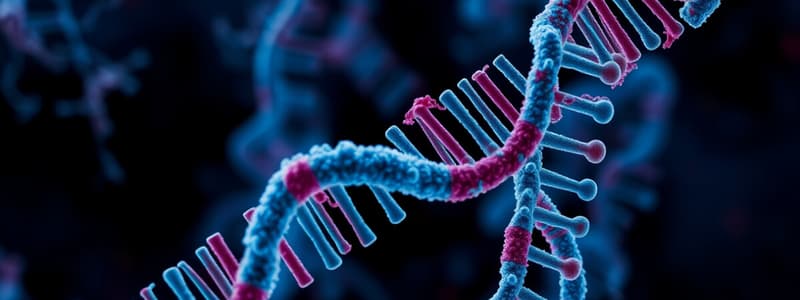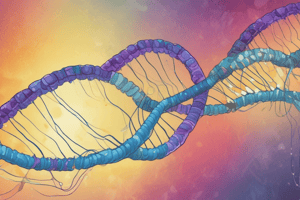Podcast
Questions and Answers
What is the key difference between prokaryotic and eukaryotic gene expression?
What is the key difference between prokaryotic and eukaryotic gene expression?
- Eukaryotes have simpler core cis-elements for splicing compared to prokaryotes.
- Prokaryotes have separate compartments for transcription and translation, while eukaryotes do not.
- Prokaryotes have more complex gene structures with longer introns compared to eukaryotes.
- Eukaryotes have separate compartments for transcription and translation, providing opportunities for posttranscriptional regulation. (correct)
- Regulatory RNA-binding proteins are only found in eukaryotic cells.
Which of the following is not a core cis-element required for pre-mRNA splicing?
Which of the following is not a core cis-element required for pre-mRNA splicing?
- Exonic splicing enhancer (correct)
- Branch point sequence
- Polypyrimidine tract
- 5' splice site
- 3' splice site
How do regulatory RNA-binding proteins like SR proteins and hnRNPs affect splicing?
How do regulatory RNA-binding proteins like SR proteins and hnRNPs affect splicing?
- They are not involved in the regulation of splicing.
- They always repress splicing by binding to cis-elements.
- Their effect on splicing depends on their binding position relative to the regulated exon. (correct)
- They always promote splicing by binding to cis-elements.
- They only interact with the core spliceosomal components, not cis-elements.
What is the role of the spliceosome in pre-mRNA splicing?
What is the role of the spliceosome in pre-mRNA splicing?
How do eukaryotes ensure accurate splicing despite having longer and more degenerate splice sites compared to prokaryotes?
How do eukaryotes ensure accurate splicing despite having longer and more degenerate splice sites compared to prokaryotes?
What is the primary function of the spliceosome in pre-mRNA splicing?
What is the primary function of the spliceosome in pre-mRNA splicing?
Which of the following is an example of RNA editing in eukaryotes?
Which of the following is an example of RNA editing in eukaryotes?
What is the primary function of mRNA localization in eukaryotic cells?
What is the primary function of mRNA localization in eukaryotic cells?
Which enzyme is responsible for the conversion of cytidine to uridine in eukaryotic mRNAs?
Which enzyme is responsible for the conversion of cytidine to uridine in eukaryotic mRNAs?
What is the primary function of the IRE-IRE-BP system in regulating mRNA stability?
What is the primary function of the IRE-IRE-BP system in regulating mRNA stability?
What is the primary mechanism by which alternative splicing increases protein diversity in eukaryotes?
What is the primary mechanism by which alternative splicing increases protein diversity in eukaryotes?
How do splicing enhancers and silencers regulate alternative splicing?
How do splicing enhancers and silencers regulate alternative splicing?
What is the role of the Sxl, Tra, and Dsx proteins in sex determination in Drosophila?
What is the role of the Sxl, Tra, and Dsx proteins in sex determination in Drosophila?
How does alternative splicing of the Transformer (Tra) gene contribute to sex determination in Drosophila?
How does alternative splicing of the Transformer (Tra) gene contribute to sex determination in Drosophila?
What is the significance of the alternative splicing of the Doublesex (Dsx) gene in Drosophila sex determination?
What is the significance of the alternative splicing of the Doublesex (Dsx) gene in Drosophila sex determination?
What is the primary function of RNA editing by ADAR enzymes in eukaryotes?
What is the primary function of RNA editing by ADAR enzymes in eukaryotes?
How does the IRE-IRE-BP system regulate the stability of the transferrin receptor mRNA?
How does the IRE-IRE-BP system regulate the stability of the transferrin receptor mRNA?
What is the primary biological function of mRNA localization in eukaryotic cells?
What is the primary biological function of mRNA localization in eukaryotic cells?
How can dysregulation of RNA-based mechanisms contribute to disease in humans?
How can dysregulation of RNA-based mechanisms contribute to disease in humans?
What is the primary biological function of the APOBEC1-mediated RNA editing in eukaryotes?
What is the primary biological function of the APOBEC1-mediated RNA editing in eukaryotes?
What is the primary purpose of using reporter assays to study splicing regulation?
What is the primary purpose of using reporter assays to study splicing regulation?
Which of the following techniques is commonly used to identify RNA-binding proteins that interact with specific cis-elements?
Which of the following techniques is commonly used to identify RNA-binding proteins that interact with specific cis-elements?
What is the primary advantage of using high-throughput sequencing methods to study posttranscriptional regulation?
What is the primary advantage of using high-throughput sequencing methods to study posttranscriptional regulation?
How do researchers use biochemical approaches to study the interaction between RNA-binding proteins and cis-elements?
How do researchers use biochemical approaches to study the interaction between RNA-binding proteins and cis-elements?
What is the primary advantage of using genetic approaches to study posttranscriptional regulation?
What is the primary advantage of using genetic approaches to study posttranscriptional regulation?
Flashcards are hidden until you start studying
Study Notes
Gene Expression in Prokaryotes vs Eukaryotes
- Eukaryotes possess separate cellular compartments for transcription and translation, allowing for posttranscriptional regulation.
- Prokaryotes lack this compartmentalization, resulting in coupled transcription and translation.
- Eukaryotes have complex gene structures with longer introns, contrasting with prokaryotic genes.
- Regulatory RNA-binding proteins are predominantly found in eukaryotic cells, playing crucial roles in gene expression modulation.
Pre-mRNA Splicing Core Elements
- Core cis-elements crucial for pre-mRNA splicing include 5' splice site, 3' splice site, branch point sequence, and polypyrimidine tract.
- Exonic splicing enhancers are not considered core cis-elements required for pre-mRNA splicing.
Role of RNA-Binding Proteins in Splicing
- The influence of regulatory RNA-binding proteins (like SR proteins and hnRNPs) on splicing is context-dependent, based on their binding positions relative to regulated exons.
- These proteins can both promote and repress splicing through their interaction with various cis-elements.
Function of the Spliceosome
- The spliceosome identifies 5' and 3' splice sites and facilitates the removal of introns while ligating exons.
- It plays a role in alternative splicing by interacting with splicing enhancers and silencers.
Eukaryotic Splicing Mechanisms
- Eukaryotic cells use additional cis-elements and trans-acting factors to ensure accurate splicing, despite longer and more complicated splice sites compared to prokaryotes.
mRNA Editing in Eukaryotes
- RNA editing by ADAR enzymes involves converting adenosine to inosine within mRNA transcripts.
- APOBEC1 carries out RNA editing that converts cytidine to uridine.
mRNA Localization and its Functions
- The primary role of mRNA localization is to control the development of multicellular organisms and ensure efficient translation.
- Dysregulation of mRNA localization can lead to disease.
IRE-IRE-BP System in mRNA Stability
- This system stabilizes transferrin receptor mRNA when iron levels are low, thereby regulating iron homeostasis.
Alternative Splicing and Its Impact
- Alternative splicing allows a single gene to produce multiple mRNA isoforms, enhancing protein diversity.
- Splicing enhancers and silencers modulate alternative splicing through RNA-binding protein interactions.
Drosophila Sex Determination
- Proteins like Sxl, Tra, and Dsx are vital in regulating alternative splicing of key genes essential for determining sex in Drosophila.
- Specifically, Tra produces a functional protein only in females, while Dsx generates transcription factors crucial for male or female development.
Dysregulation of RNA-Based Mechanisms
- Dysregulation in splicing or mRNA editing can lead to various diseases, including neurological disorders and metabolic issues.
Modern Experimental Approaches
- Reporter assays measure the activity of splicing enhancers and silencers to understand splicing regulation.
- RNA immunoprecipitation and crosslinking-mass spectrometry are techniques used to identify RNA-binding proteins interacting with specific cis-elements.
- High-throughput sequencing allows researchers to analyze alternative splicing patterns on a genome-wide scale.
- Biochemical approaches help identify RNA-binding proteins interacting with specific cis-elements.
- Genetic approaches are vital for revealing novel regulatory mechanisms and discovering RNA-binding proteins.
Studying That Suits You
Use AI to generate personalized quizzes and flashcards to suit your learning preferences.




